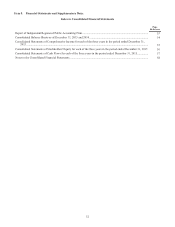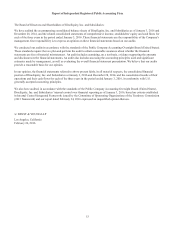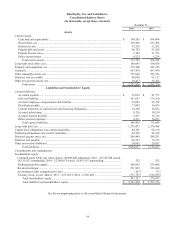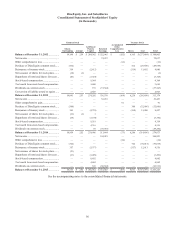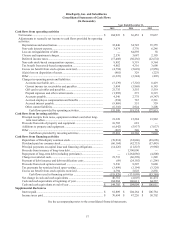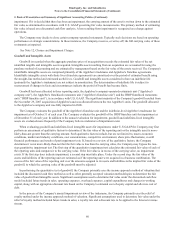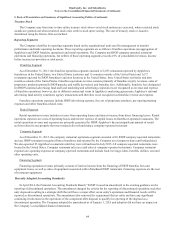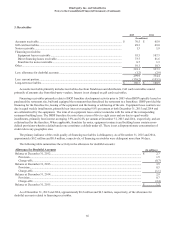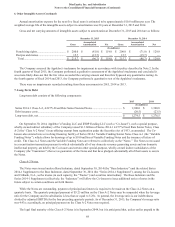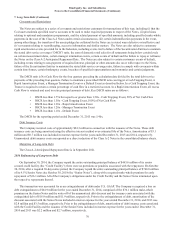IHOP 2015 Annual Report Download - page 80
Download and view the complete annual report
Please find page 80 of the 2015 IHOP annual report below. You can navigate through the pages in the report by either clicking on the pages listed below, or by using the keyword search tool below to find specific information within the annual report.DineEquity, Inc. and Subsidiaries
Notes to the Consolidated Financial Statements (Continued)
2. Basis of Presentation and Summary of Significant Accounting Policies (Continued)
60
impairment. If it is decided that there has been an impairment, the carrying amount of the asset is written down to the estimated
fair value as determined in accordance with U.S. GAAP governing fair value measurements. The primary method of estimating
fair value is based on a discounted cash flow analysis. A loss resulting from impairment is recognized as a charge against
operations.
The Company may decide to close certain company-operated restaurants. Typically such decisions are based on operating
performance or strategic considerations. In these instances, the Company reserves, or writes off, the full carrying value of these
restaurants as impaired.
See Note 12, Closure and Impairment Charges.
Goodwill and Intangible Assets
Goodwill is recorded when the aggregate purchase price of an acquisition exceeds the estimated fair value of the net
identified tangible and intangible assets acquired. Intangible assets resulting from an acquisition are accounted for using the
purchase method of accounting and are estimated by management based on the fair value of the assets received. The Company's
identifiable intangible assets are comprised primarily of the Applebee's tradename and Applebee's franchise agreements.
Identifiable intangible assets with finite lives (franchise agreements) are amortized over the period of estimated benefit using
the straight-line method and estimated useful lives. Goodwill and intangible assets considered to have an indefinite life
(primarily the Applebee's tradename) are not subject to amortization. The determination of indefinite life is subject to
reassessment if changes in facts and circumstances indicate the period of benefit has become finite.
Goodwill has been allocated to three reporting units, the Applebee's company-operated restaurants unit (“Applebee's
company unit”), the Applebee's franchised restaurants unit (“Applebee's franchise unit”) and the IHOP franchised restaurants
unit (“IHOP franchise unit”), in accordance with U.S. GAAP. The significant majority of the Company's goodwill resulted from
the November 29, 2007 acquisition of Applebee's and was allocated between the two Applebee's units. The goodwill allocated
to the Applebee's company unit was fully impaired in 2008.
The Company evaluates the goodwill of the Applebee's franchise unit and the indefinite-lived Applebee's tradename for
impairment as of October 31 of each year. The Company evaluates the goodwill of the IHOP franchise unit for impairment as
of December 31 of each year. In addition to the annual evaluation for impairment, goodwill and indefinite-lived intangible
assets are evaluated more frequently if the Company believes indicators of impairment exist.
When evaluating goodwill and indefinite-lived intangible assets for impairment, under U.S GAAP the Company may first
perform an assessment of qualitative factors to determine if the fair value of the reporting unit or the intangible asset is more-
likely-than-not greater than the carrying amount. Such qualitative factors include, but are not limited to, macro-economic
conditions, market and industry conditions, cost considerations, competitive environment, share price fluctuations, overall
financial performance and results of past impairment tests. If, based on a review of the qualitative factors, the Company
determines it is not more-likely-than-not that the fair value is less than the carrying value, the Company may bypass the two-
step quantitative impairment test. The first step of the quantitative impairment test calculates the estimated fair value of each of
the reporting units and compares it to the carrying value. If the fair value is in excess of the carrying value, no impairment
exists. If the first step does indicate impairment, a second step must take place. Under the second step, the fair value of the
assets and liabilities of the reporting unit are estimated as if the reporting unit were acquired in a business combination. The
excess of the fair value of the reporting unit over the amounts assigned to its assets and liabilities is the implied fair value of the
goodwill, to which the carrying value of the goodwill must be adjusted.
In performing the quantitative test of goodwill, the Company primarily uses the income approach method of valuation that
included the discounted cash flow method as well as other generally accepted valuation methodologies to determine the fair
value of goodwill and intangible assets. Significant assumptions used to determine fair value under the discounted cash flow
model included future trends in sales, operating expenses, overhead expenses, capital expenditures and changes in working
capital, along with an appropriate discount rate based on the Company's estimated cost of equity capital and after-tax cost of
debt.
In the process of the Company's annual impairment review of the tradename, the Company primarily uses the relief of
royalty method under the income approach method of valuation. Significant assumptions used to determine fair value under the
relief of royalty method included future trends in sales, a royalty rate and a discount rate to be applied to the forecast revenue
stream.




